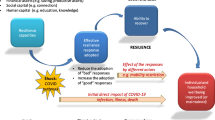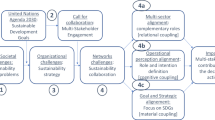Abstract
In mid 2011, the Food and Agriculture Organization (FAO) and World Food Programme (WFP) formally launched the global Food Security Cluster (FSC) as the UN’s global mechanism for coordinating food security responses in emergencies worldwide. The need for greater coordination of food security response in emergencies is enormous: Not only is the number of actors growing ever larger, the operating environment is more complex, and the range of responses requires substantially greater levels of skill than ever in analysis, planning, implementation, and monitoring and evaluation. Will this new mechanism provide the leadership needed for complex, multi-dimensional responses needed to protect food security and livelihoods in disasters? What are the special challenges the cluster faces? This paper analyzes a series of country level case studies and key informant interviews with stakeholders in a range of roles to address these questions.

Similar content being viewed by others
Notes
The cluster is referred to as the “Food Security Cluster” or the global (with lower case) Food Security Cluster. The upper case “Global” was excluded because of a perceived potential confusion with the Committee on World Food Security. For the purposes of this paper, the cluster is referred to as the “global Food Security Cluster” or “global FSC.”
Ushahidi is an open-source crisis-mapping platform that gathers information through social media (Twitter, Facebook, blogs) and mobile phone text messages to identify and map clusters of incidents and urgent needs in order to assist response efforts (Heinzelman and Waters 2010). Ushahidi rose to prominence rapidly during the search and rescue phase of the Haiti crisis.
Little documentation exists on the “Survival Strategy”—everything cited above is from interviews.
Note that emergency response can include life saving or life protecting interventions as well as those that protect livelihoods. The question has more to do with transitional programing and longer-term disaster management including risk reduction activities, preparedness planning and social protection.
It should be noted that this discussion is not about whether or not livelihood-protecting activities are part of humanitarian response—it is about the relationship to transitions, and disaster risk management activities that are critically important to preventing food insecurity in crisis, but inevitably labeled part of “longer-term” activities.
References
Active Learning Network for Accountability and Performance in Humanitarian Action (ALNAP). (2009). The state of the humanitarian system. London: ALNAP.
Atkisson, S. (2010). Haiti wants food aid to stop? CBS News. Retrieved November 7, 2011 from http://www.cbsnews.com/stories/2010/04/21/eveningnews/main6419171.shtml.
Balde, M. D., Crisp, J., Macleod, E., & Tennant, V. (2011). Shelter from the storm: A real-time evaluation of UNHCR’s response to the emergency in Côte d’Ivoire and Liberia. Geneva: Policy Development and Evaluation Service, UNHCR.
Bolton, M. (2011). Human Security after state collapse: Global security in post earthquake Haiti. London: London School of Economics Global Governance.
Cavallo, E., Powell, A., & Becerra, O. (2010). Estimating the direct economic damages of the earthquake in Haiti. The Economic Journal, 120(08), 298–312.
Chan, C. (2010). Agriculture in post-quake Haiti. The Epoch Times, February 24.
Coordination Nationale de la Sécurité Alimentaire (CNSA). (2010). Rapid post-earthquake emergency food security assessment. Port-au-Prince: CNSA.
The Economist (2011). Chaotic Côte d’Ivoire: Don’t forget it. March 12.
Famine Early Warning Systems Network (FEWS NET). (2011). West Africa food security alert. Washington: USAID.
FAO. (2010a). Special brief: Haiti earthquake. Rome: FAO and European Union.
FAO. (2010b). Cluster coordination guidance: Guidance for FAO staff working at country level in humanitarian and early recovery operations. Rome: FAO.
FAO. (2010c). Cluster Mapping Exercise 2010. Rome: FAO.
FAO/WFP. (2010a). The state of food insecurity 2010. Food insecurity in protracted crises. Rome: FAO/WFP.
FAO/WFP. (2010b). Joint FAO/WFP information note: FAO/WFP co-led emergency/humanitarian food security cluster. Rome: FAO/WFP.
Grunewald, F., & Binder, A. (2010). Inter-agency real-time evaluation in Haiti: 3 months after the earthquake. Global Public Policy Institute and Groupe URD.
Heinzelman, J., & Waters, C. (2010). Crowdsourcing crisis information in disaster affected Haiti. Washington: United States Institute of Peace.
House of Commons. (2011). The humanitarian response to the Pakistan floods. London: House of Commons International Development Committee.
Inter-Agency Standing Committee (IASC). (2006). Guidance note on using the cluster approach to strengthen humanitarian response. Geneva: Inter-Agency Standing Committee.
Inter-Agency Standing Committee (IASC). (2010). Response to the humanitarian crisis in Haiti: Following the 12 January 2010 earthquake. IASC: Inter-Agency Standing Committee. Geneva and New York.
International Organization for Migration (IOM). (2010). Haiti earthquake displacement and shelter strategy. International Organization for Migration. Port-au-Prince: IOM.
Kronstadt, K. A., Sheikh, P. A., & Vaughn, B. (2010). Flooding in Pakistan: Overview and issues for congress. Washington: Congressional Research Service.
Maxwell, D., & Sadler, K. (2011). Responding to food insecurity and malnutrition in crises. Chapter 5 in World Disaster Report 2011. Geneva: International Federation of Red Cross and Red Crescent Societies.
Office for the Coordination of Humanitarian Affairs (OCHA) (2011a). The financial tracking service. Office for the Coordination of Humanitarian Affairs. www.fts.unocha.org/ (Accessed October 5, 2011).
Pollastro, R., Nagrah, A., Steen, N., & Zafar, F (2011). Inter-agency real time evaluation of the humanitarian response to Pakistan’s 2010 flood crisis. DARA.
Rencoret, N., Stoddard, A., Haver, K., Taylor, G., & Harvey, P. (2010). Haiti earthquake response: Context analysis. ALNAP, DAC Network on Development Evaluation and UNEG.
Schwartz, T., Pierre, Y.-F., & Calpas, E. (2011). Building assessments and rubble removal in quake-affected neighborhoods in Haiti. Washington: USAID.
Steets, J., Grunewald, F., Binder, A., de Geoffroy, V., Kauffmann, D., Kruger, S., et al. (2010). Cluster approach evaluation 2 synthesis report. Global Public Policy Institute and Groupe URD.
Stoddard, A., Harmer, A., Haver, K., Salomons, D., & Wheeler, V. (2007). Cluster approach evaluation final. New York: OCHA Evaluation and Studies Section.
Strauss, S. (2011). It’s sheer horror here: patterns of violence during the first 4 months of Côte d’Ivoire’s post-electoral crisis. African Affairs, 110(440), 481–89.
Stumpenhorst, M., Stumpenhorst, R., & Razum, O. (2011). The UN OCHA cluster approach: gaps between theory and practice. Journal of Public Health 19(6):587–592.
United Nations. (2005). Humanitarian response review. New York: United Nations Office for the Coordination of Humanitarian Affairs (OCHA).
United Nations. (2010). Pakistan floods emergency response plan revision. New York: UN OCHA.
United Nations. (2011a). Pakistan floods: 1 year on. Islamabad: United Nations Flood Response.
United Nations. (2011b). Emergency humanitarian action plan: Côte d’Ivoire and neighboring countries. West Africa: UN OCHA.
US Institute for Peace. (2010). Haiti: A republic of NGOs? USIP peace brief 23. Washington: USIP.
Webb, P. (2009). Malnutrition in emergencies: the framing of nutrition concerns in the humanitarian appeals process, 1992 to 2009. Food and Nutrition Bulletin, 30(4), 379–389.
WFP. (2011). Côte d’Ivoire post-electoral crisis. Dakar: WFP.
Author information
Authors and Affiliations
Corresponding author
Rights and permissions
About this article
Cite this article
Maxwell, D., Parker, J. Coordination in food security crises: a stakeholder analysis of the challenges facing the global food security cluster. Food Sec. 4, 25–40 (2012). https://doi.org/10.1007/s12571-012-0166-3
Received:
Accepted:
Published:
Issue Date:
DOI: https://doi.org/10.1007/s12571-012-0166-3




